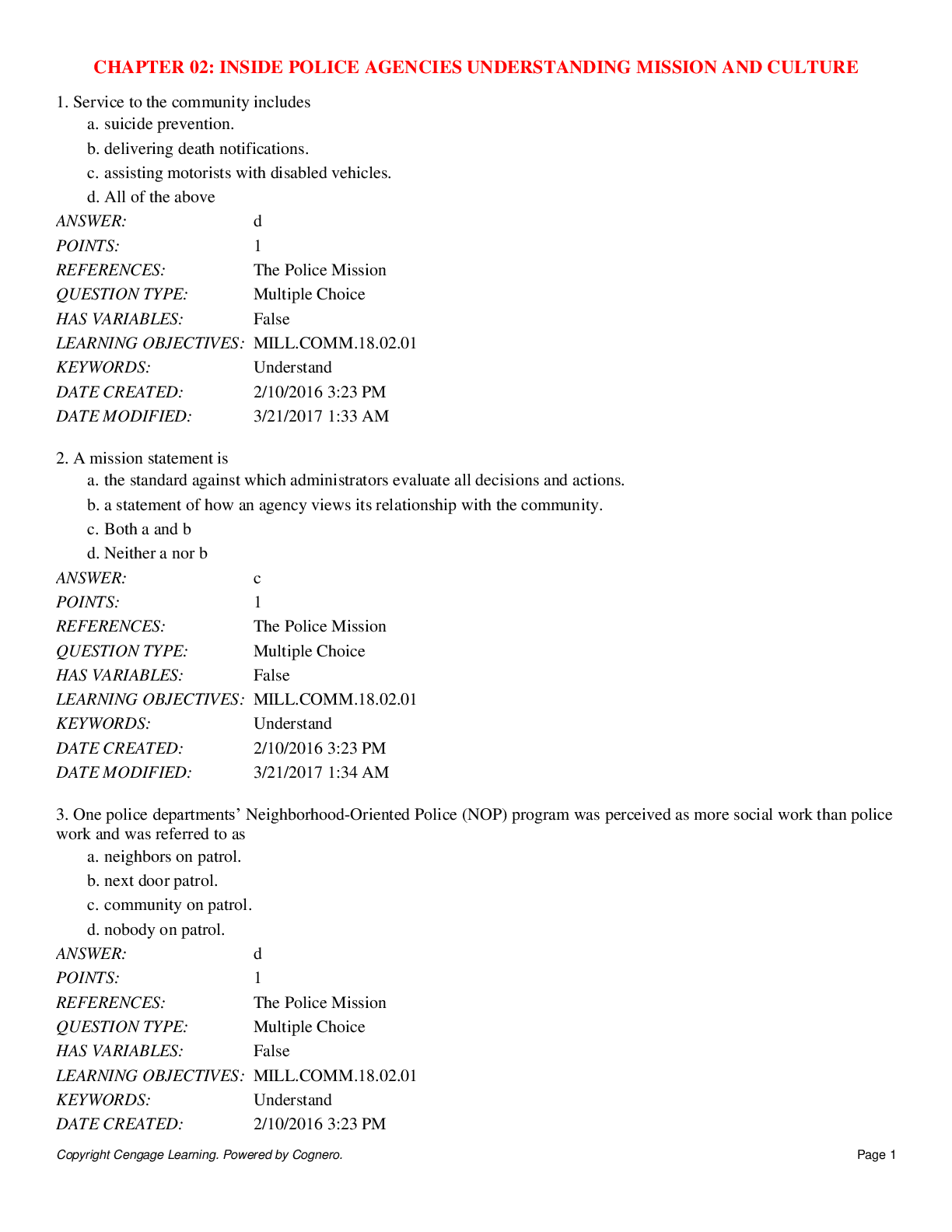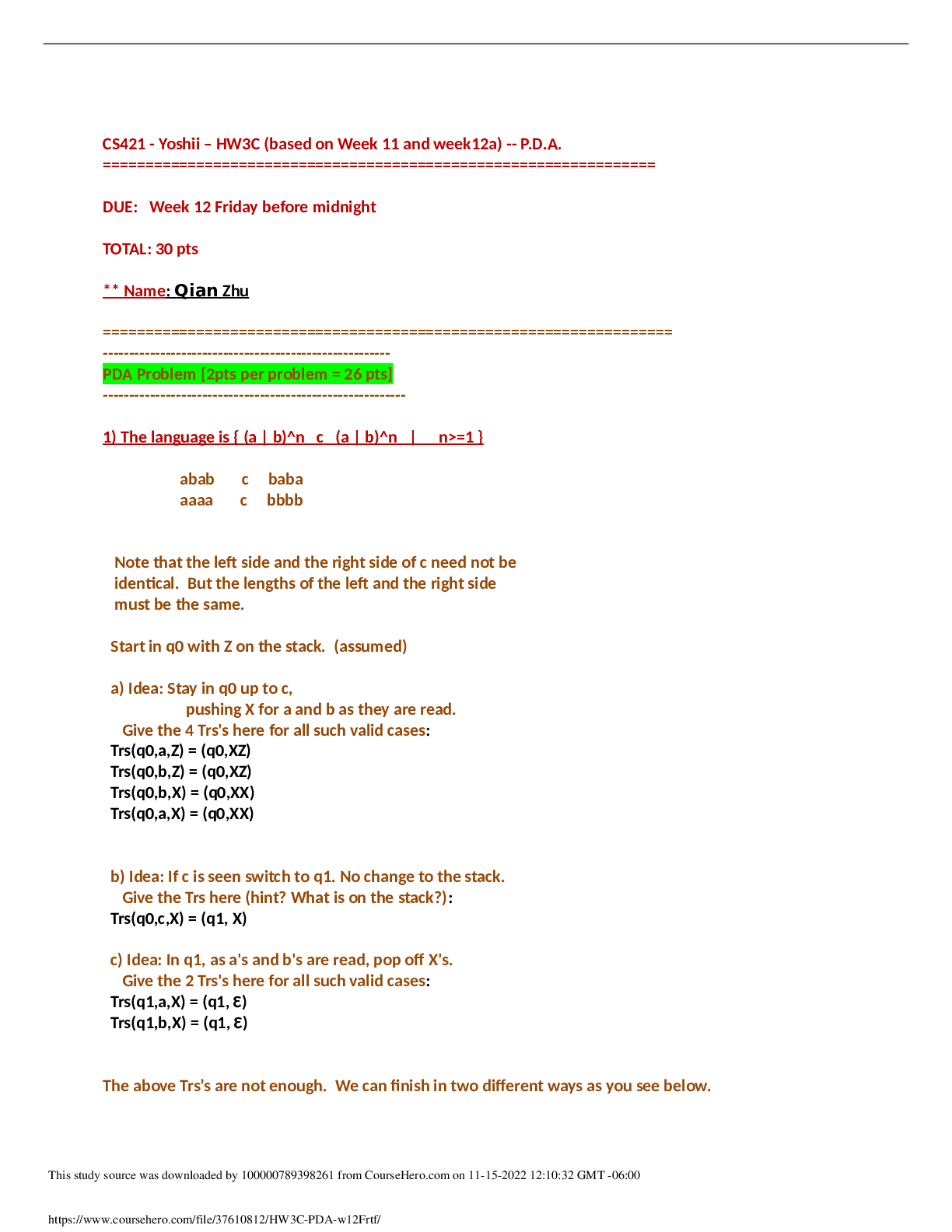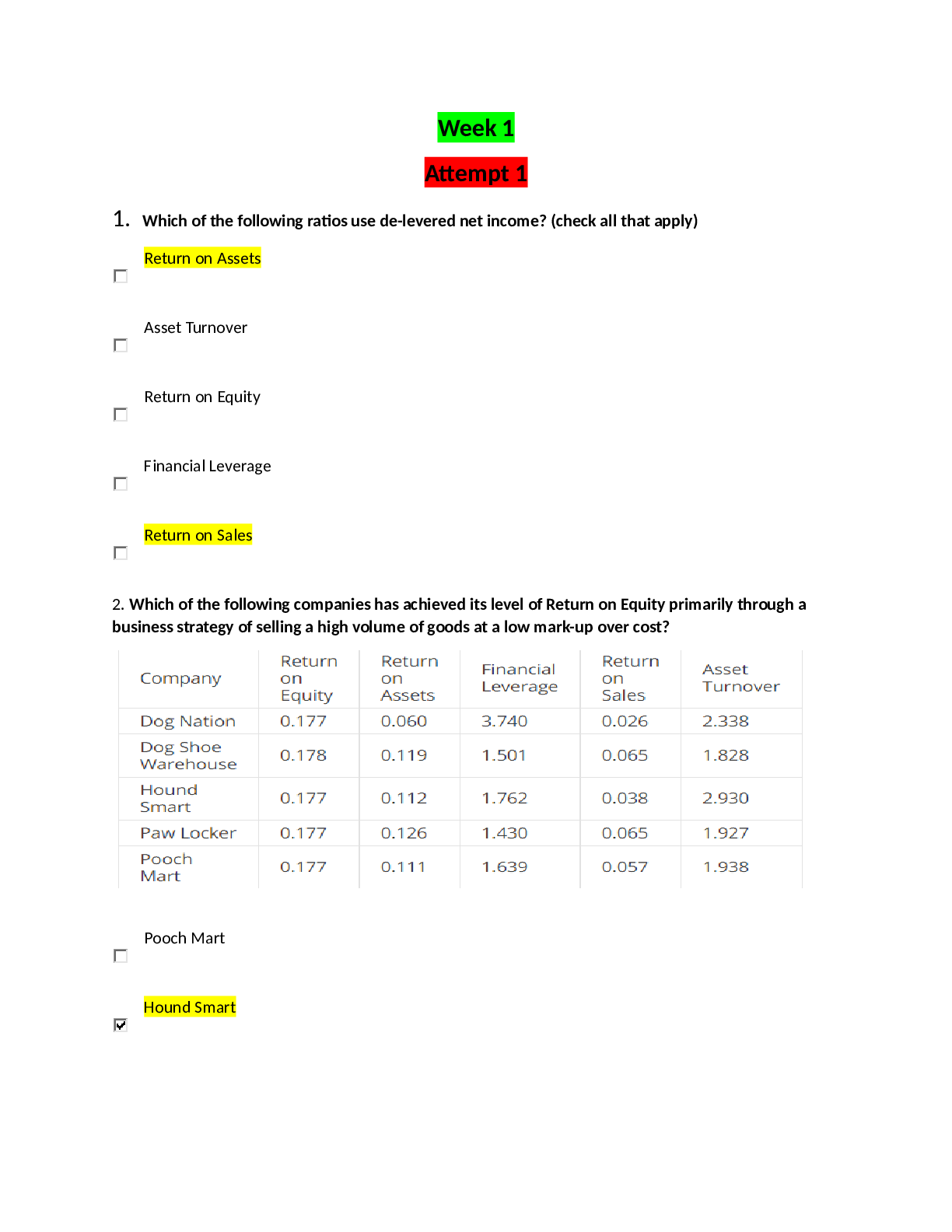Cummunity Policing > QUESTIONS & ANSWERS > CHAPTER 02: INSIDE POLICE AGENCIES UNDERSTANDING MISSION AND CULTURE. All Answers. (All)
CHAPTER 02: INSIDE POLICE AGENCIES UNDERSTANDING MISSION AND CULTURE. All Answers.
Document Content and Description Below
1. Service to the community includes a. suicide prevention. b. delivering death notifications. c. assisting motorists with disabled vehicles. d. All of the above 2. A mission st... atement is a. the standard against which administrators evaluate all decisions and actions. b. a statement of how an agency views its relationship with the community. c. Both a and b d. Neither a nor b 3. One police departments’ Neighborhood-Oriented Police (NOP) program was perceived as more social work than police work and was referred to as a. neighbors on patrol. b. next door patrol. c. community on patrol. d. nobody on patrol. 4. The statement, “There is no right way to do a wrong thing” refers to a. criminal behavior. b. ethics. c. rules of criminal procedure. d. mission statements. 5. Each police agency exercises discretion when it establishes its a. procedures. b. policies. c. mission. d. All of the above 6. The police image is affected by a. individual officer backgrounds. b. the media. c. officers’ personal experiences. d. All of the above 7. According to the text, the public expects the police to a. enforce the law against others. b. give breaks only to their own family and friends. c. help them when they have a problem. d. All of the above 8. Negative contacts a. are unpleasant interactions between the police and the public. b. occur when an officer performs poorly at the firing range. c. result when investigators are unable to develop leads. d. None of the above 9. Because of their shared experiences and unique exposure to their community, many police officers develop a fierce loyalty to a. poor people. b. minorities. c. each other. d. the community. 10. The commonly used police practice of choosing among possible courses of action or inaction when dealing with lawbreakers is known as a. detachment. b. discretion. c. the fairness doctrine. d. the patronage system. 11. According to the text, police officers are most likely to investigate a. burglary. b. noise complaints. c. animal complaints. d. white collar crime. 12. The relationship between the police and the community is profoundly affected by a. police use of discretion. b. police use of force. c. Both a and b d. Neither a nor b 13. According to the text, the majority of an officer’s actions involve a. high-speed chases. b. apprehending criminals. c. service to the community. d. Both a and b 14. Selective enforcement is a. the opposite of discretion. b. the use of police discretion. c. necessary because people expect all laws to be enforced. d. the principle involved in random sobriety checks. 15. A police department might want to include the community’s input when developing a mission statement because it a. improves police–community relations. b. decreases the possibility of the agency accomplishing its mission. c. maintains officer support. d. decreases community complaints. 16. This U.S. Supreme Court decision in Terry v. Ohio (1968) recognized the role that discretion plays in policing and a. granted police the authority to conduct community policing field tests without court approval. b. granted police the power to conduct a search without a warrant prior to arrest. c. granted police authority to stop and question people in field interrogations. d. granted police the authority to question people without having to read them their rights. 17. The increased officer discretion necessary for community policing is a concern to many police administrators who fear loss of control of their a. officers. b. prosecutorial discretion. c. parole searches. d. community relationships. 18. The lowest-ranking and newest patrol officers typically have a. no discretion. b. the least amount of discretion. c. the greatest amount of discretion. d. the same amount of discretion as civilian personnel. 19. Reflective sunglasses, handcuffs, and gun-tie tacks can contribute to a ______________ police image. a. positive b. professional c. negative d. compliant 20. Recent studies on police use of force concluded all of the following are true except: a. Less than half of 1% of the population actually experienced force during contact with the police. b. In most instances, the force used was of the lower or most moderate level. c. Suspect characteristics, such as race, were not related to the use of force. d. Most citizens do not understand or support law enforcement. 21. The transformation of good people into evil people is called a. the Noble Cause effect. b. the integrity lapse effect. c. the Lucifer effect. d. the Halloween effect. 22. Community policing emphasizes a. a wider use of police discretion. b. tighter control over officers’ use of discretion. c. the need for officers to strictly and fairly enforce all laws in every instance. d. solidarity of the police. 23. The average citizen holds many mistaken beliefs about police work due to television shows that portray the police as playing “fast and loose” with the truth. This is called a. media bias. b. the CSI effect. c. factual documentation. d. a negative image portrayal. 24. A vision statement is a. more philosophical than a mission statement. b. the same as a mission statement. c. a review of a department’s past. d. unnecessary for police departments. 25. Which of the following best describes an ethics-check question? a. Is it balanced? b. Will anybody find out? c. Is it cost-effective? d. All of the above 26. A guide to officers as to what they should or should not do is called a. baseline standards. b. integrity guides. c. civility. d. values. 27. Paoline’s study of police culture a. supported the conventional wisdom of isolation and a “them-versus-us” worldview. b. found that isolation and the “them-versus-us” worldview is compatible with community policing. c. found that few officers were confident that they could gain citizens’ cooperation. d. reported that many officers have attitudes and outlooks that vary from those of traditional police culture. 28. The majority of police actions have less to do with ______________ and involve service to the community. a. order maintenance b. law enforcement c. time maintenance d. social services 29. According to the text, the law enforcement community is perhaps the best and quickest at culling these types of individuals: a. Supervisors b. Consistent c. managers d. Bad people 30. All of the following are a downside of police discretion except: a. The decisions not to invoke the criminal process are seldom subject to review. b. It determines the outer limit of law enforcement. c. The police have the power to decide whom they will arrest. d. The officers are subject to immediate supervisory review. 31. According to the text, ______________ and secrecy within a police department can result in a code of silence. a. corruption b. brutality c. solidarity d. paranoia 32. Controversy over the use of force is almost always discussed in terms of a. police–citizen interactions. b. use of deadly force. c. officer presence at the scene. d. police brutality. 33. According to the text, police departments today place a greater emphasis on what mindset when approaching how to police? a. Warrior b. Coddling c. Guardian d. Authoritative 34. Statistics from 2013 show that some college is required for what percentage of local agencies? a. 25% b. 72% c. 32% d. 17% 35. A set of informal values, beliefs, and expectations passed on to new police officers is called what? a. Policy b. Mission c. Value statement d. Police culture 36. Law enforcement agencies rarely, if ever, seek input from the community when developing mission statements. a. True b. False 37. The police image is affected by individual officers’ backgrounds, the media, and citizens’ personal experiences with the criminal justice system. a. True b. False 38. Police brutality is considered a problem by only a small segment of the public. a. True b. False 39. A 2005 study showed attitudes toward the police were more easily influenced by what a person heard about someone else’s experience with the police. a. True b. False 40. The police image is affected by the police uniform and the equipment that police officers wear and use. a. True b. False 41. Chief Justice Warren Burger once stated: “The officer working the beat makes more decisions and exercises broader discretion affecting the daily lives of people every day and to a greater extent than a judge will exercise in a week.” a. True b. False 42. The use of police discretion is governed in every case by policies and procedures that cover every possible circumstance an officer may face. a. True b. False 43. According to the text, when given a ticket, law-abiding citizens believe they should be excused and that the police should concentrate on “real” criminals. a. True b. False 44. Generally speaking, officers have broad discretion in deciding under what circumstances to enforce laws. a. True b. False 45. Negative contacts, as defined in the text, will result in the police being unable to perform their duties. a. True b. False 46. The Hug-a-Bear Program is designed to make police officer contacts less negative. a. True b. False 47. Community standards influence how the police enforce laws. a. True b. False 48. Ethical behavior by individual officers and by the department as a whole is indispensable to effective police–community partnerships. a. True b. False 49. Although officers often operate independently, it is important to remember that the community watches how officers perform their duties. a. True b. False 50. Police integrity can be defined as “the normative inclination among police to resist temptations to abuse the rights and privileges of their occupation.” a. True b. False 51. Traditionally, police officers have been a fairly heterogeneous group. a. True b. False 52. The media have little effect on public opinion. a. True b. False 53. Police are the only agencies within the criminal justice system who have discretionary powers. a. True b. False 54. The Lucifer effect is limited to individuals, not organizations. a. True b. False 55. Police discretion is not beneficial because all statutes are current and must be enforced to the letter of the law. a. True b. False 56. A _______________ is a written declaration of purpose. 57. The informal values, beliefs, and expectations of officers are known collectively as _______________. 58. Unpleasant interactions between the police and the public are known as _______________. 59. Controversy on the use of force by police is almost always discussed in terms of _______________. 60. The _______________ is affected by individual backgrounds, the media, and citizens’ personal experiences with the criminal justice system. 61. Ethics involves integrity, honesty, values, standards, courage, and ________________. 62. According to the text, honesty is synonymous with __________________. 63. A _______________ is simply a belief or philosophy that is meaningful to us. 64. According to the text, _________________ has been described as being confronted with a difficult problem and making the right decision despite potentially adverse personal or professional consequences. 65. The __________________ is also shaped by appearance and police actions. 66. Describe one of the four expectations of citizens according to Skogan. 67. As listed in the text, describe the building blocks of ethics. 68. Skolnick’s classic description, “A Sketch of the Policeman’s ‘Working Personality’” (1966), included such descriptors as social isolation, solidarity, and authority. Describe what characteristics were identified in his definition. 69. Discuss the continuum of compromise and why it is referred to as the “slippery slope.” 70. Compare and contrast a mission statement and vision statement. Which document serves a greater purpose of summarizing how police officers should respond to their community? [Show More]
Last updated: 2 years ago
Preview 1 out of 22 pages

Buy this document to get the full access instantly
Instant Download Access after purchase
Buy NowInstant download
We Accept:

Reviews( 0 )
$8.00
Can't find what you want? Try our AI powered Search
Document information
Connected school, study & course
About the document
Uploaded On
Jan 15, 2020
Number of pages
22
Written in
Additional information
This document has been written for:
Uploaded
Jan 15, 2020
Downloads
0
Views
104






.png)
.png)
.png)
.png)
.png)
.png)
.png)

